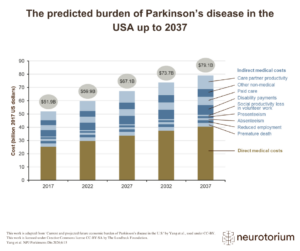Index for
slide deck
Title
-1024x576.jpg)
Treatment principles
The presentation covers the current treatment and medications for Parkinson’s Disease.
Current treatments and medications
-1024x576.jpg)
Current treatments and medications
-1024x576.jpg)
Levodopa
Once swallowed, orally-administered levodopa moves down the gastrointestinal tract – a process sometimes delayed in PD due to impaired gastric motility – until it is absorbed into the blood via the duodenum.[van Gerpen, 2014] From the circulation, levodopa eventually make…
-1024x576.jpg)
Mechanism of action of levodopa plus a peripheral dopa decarboxylase inhibitor
The slide shows the mechanism of action of levodopa, when taken in combination with a dopa decarboxylase inhibitor.
-1024x576.jpg)
Strengths and limitations of levodopa
Although levodopa has been a major success story for the management of PD, it does have some limitations, such as the development of dopa-related response fluctuations (both motor and non-motor) and drug-induced dyskinesias.[Hametner et al., 2010]
In a patient experienci…
-1024x576.jpg)
Change in levodopa response over time – ‘wearing-off’
Levodopa is the major symptomatic therapy for PD and provides benefit to virtually all patients.[Obeso et al., 2000] During the so-called ‘honeymoon’ period, the effects of levodopa tend to be long-lasting and side effects are tolerable.[Obeso et al., 2000] Beyond this ‘h…
-1024x576.jpg)
Dyskinesia and motor fluctuations
Motor complications, such dyskinesia and motor fluctuations, can greatly worsen the quality of life of patients, particularly during mid to late PD.[Chapuis et al., 2005] One of the priorities for the management of PD during this time is to optimise the administration of …
-1024x576.jpg)
Other medications used in the treatment of Parkinson’s disease (I)
Dopamine agonists play a major role in the treatment of PD.[Factor, 2008] They act by directly stimulating intact postsynaptic receptors in the brain linked to motor control.[Müller, 2012] Although they tend to be less potent than levodopa in reducing parkinsonian motor s…
-1024x576.jpg)
Other medications used in the treatment of Parkinson’s disease (II)
Patients who are experiencing ‘wearing-off’ may benefit from taking a monoamine oxidase type B inhibitor (MAO-B inhibitor).[Factor, 2008; Stochi, 2014] MAO-B inhibitors inhibit the breakdown of either dopamine or levodopa in the body, thus prolonging their therapeutic eff…
-1024x576.jpg)
Other medications used in the treatment of Parkinson’s disease (III)
Patients who are experiencing ‘wearing-off’ may benefit from taking a catechol-O-methyltransferase inhibitor (COMT inhibitor).[Factor, 2008; Stochi, 2014] COMT inhibitors inhibit the breakdown of dopamine and of levodopa in the body, thus prolonging their therapeutic effe…
-1024x576.jpg)
Other medications used in the treatment of Parkinson’s disease (IV)
Certain non-dopaminergic agents help to reduce dyskinesias through an indirect mechanism,[Factor, 2008] but have the limitation of worsening side effects, such as hallucinations and psychosis, in some individuals.[Müller, 2012] A newer non-dopaminergic agent has been rece…
-1024x576.jpg)
Holistic medicine and the multi-disciplinary approach
The primary emphasis of the care of patients with PD should focus on maximising their quality of life and reducing disability.[Prizer & Browner, 2012] Conventional medical and surgical therapies are still limited to providing only partial and temporary relief.[Prizer & Br…
-1024x576.jpg)
Exercise and Parkinson’s disease
With the exception of tremor symptoms, tailored exercise and physical activity therapies have been shown to improve all the prominent motor symptoms experienced by individuals with PD.[Borrione et al., 2014] In order to increase adherence rates, the patients themselves sh…
-1024x576.jpg)
Treatment principles in the advanced stages of Parkinson’s disease
Although levodopa and dopamine agonists are initially able to control motor symptoms effectively, eventually most patients will start to develop motor complications, which comprise ON– OFF motor fluctuations and dyskinesia.[Stochi, 2014]
‘Wearing-off’ is one of the more t…


-1024x576.jpg)
-1024x576.jpg)
-1024x576.jpg)
-1024x576.jpg)
-1024x576.jpg)
-1024x576.jpg)
-1024x576.jpg)
-1024x576.jpg)
-1024x576.jpg)
-1024x576.jpg)
-1024x576.jpg)
-1024x576.jpg)


